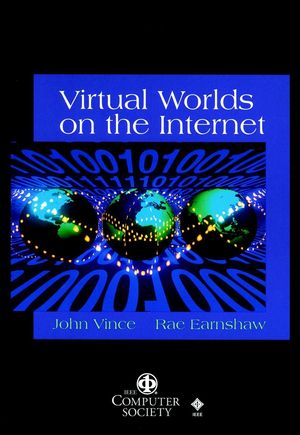Virtual Worlds on the InternetISBN: 978-0-8186-8700-6
Paperback
360 pages
January 1999, Wiley-IEEE Computer Society Press
 This is a Print-on-Demand title. It will be printed specifically to fill your order. Please allow an additional 15-20 days delivery time. The book is not returnable.
|
||||||
Introduction
Chapter 1: Data Flow Languages for Immersive Virtual Environments (Anthony Steed, Department of Computer Science, University College London).
Chapter 2: VRML Interfaces to Information Systems (Christine Clark and Adrian F. Clark, VASE Laboratory, University of Essex).
Chapter 3: VRML: A Designer's View (Stephen Boyd Davis, Centre for Electronic Arts, Middlesex University;
Helena Athoussaki, BT Laboratories).
Chapter 4: Ulysse: An Interactive Spoken Dialogue Interface to Navigate in Virtual Worlds (Christopher Godereaux, Pierre-Olivier El Guedj, Frederic Revolta, and Pierre Nugues, Institut des Sciences de la Matiere et du Rayonnement).
Chapter 5: Information Drill-Down Using Web Tools (Mikael Jern, AVS/UNIRAS).
Chapter 6: Generic Uses of Real World Data in Virtual Environments (M.W. Wright, G.C. Watson, and R.L. Middleton, Edinburgh Virtual Environment Centre, University of Edinburgh).
Chapter 7: A Generic Functional Architecture for the Development of Multiuser 3-D Environments (Tao Lin and Kevin Smith, CSIRO Mathematical and Information Sciences).
Chapter 8: Strategies for Mutability in Virtual Environments (Ben Anderson and Andrew McGrath, BT Laboratories).
Chapter 9: Bringing the MBone to Web Users (Adrian F. Clark, VASE Laboratory, University of Essex).
Chapter 10: Handling of Dynamic 2-D/3-D Graphics in Narrow-Band Mobile Services (C. Belz, H. Jung, L. Santos, and R. Strack, Computer Graphics Center (ZGDV);
P. Latva-Rasku, Nokia Research Center (NRC).
Chapter 11: Realistic Avatars and Autonomous Virtual Humans in VLNET Networked Virtual Environments (Tolga K. Capin and Daniel Thalmann, Computer Graphics Laboratory, Swiss Federal Institute of Technology;
Igor Sunday Pandzic and Nadia Magnenat Thalmann, MIRALab, University of Geneva).
Chapter 12: Interactive Cloth Simulation: Problems and Solutions (Pascal Volino and Nadia Magnenat Thalmann, MIRALab, University of Geneva).
Chapter 13: The Blob Tree: Implicit Modelling and VRML (Brian Wyvill and Andrew Guy, Department of Computer Science, University of Calgary).
Chapter 14: Automatic Generation of Virtual Worlds for Electronic Commerce Application on the Internet (Klaus M. Bauer, Computer Graphics Center (ZGDV e.V.).
Chapter 15: A Case Study in the Use of VRML 2.0 for Marketing a Product (Nick D. Burton, Alistair C. Kilgour, and Hamish Taylor, Department of Computing and Electrical Engineering, Heriot-Watt University).
Chapter 16: A Virtual Environment for Collaborative Administration (D. England, Connect Centre, University of Liverpool;
W. Prinz, GMD FIT-CSCW Institute;
K. Simarian and O. St?hl, Swedish Institute for Computer Science).
Chapter 17: Collaborative Theatre Set Design across Networks (Ian J. Palmer and Carlton M. Reeve, EIMCU, University of Bradford).
Chapter 18: Moving the Museum onto the Internet: The Use of Virtual Environments in Education about Ancient Egypt (William L. Mitchell, Department of Computing, Manchester Metropolitan University).
Chapter 19: The Virtual Reality Responsive Workbench: Applications and Experiences (Lawrence Rosenblum, James Durbin, Robert Doyle, and David Tate, Virtual Reality Lab, Naval Research Laboratory).
Chapter 20: Inner Space: The Final Frontier (David Leevers, Multimedia Communications, BICC Group).
Figures in Color
Index.
Chapter 1: Data Flow Languages for Immersive Virtual Environments (Anthony Steed, Department of Computer Science, University College London).
Chapter 2: VRML Interfaces to Information Systems (Christine Clark and Adrian F. Clark, VASE Laboratory, University of Essex).
Chapter 3: VRML: A Designer's View (Stephen Boyd Davis, Centre for Electronic Arts, Middlesex University;
Helena Athoussaki, BT Laboratories).
Chapter 4: Ulysse: An Interactive Spoken Dialogue Interface to Navigate in Virtual Worlds (Christopher Godereaux, Pierre-Olivier El Guedj, Frederic Revolta, and Pierre Nugues, Institut des Sciences de la Matiere et du Rayonnement).
Chapter 5: Information Drill-Down Using Web Tools (Mikael Jern, AVS/UNIRAS).
Chapter 6: Generic Uses of Real World Data in Virtual Environments (M.W. Wright, G.C. Watson, and R.L. Middleton, Edinburgh Virtual Environment Centre, University of Edinburgh).
Chapter 7: A Generic Functional Architecture for the Development of Multiuser 3-D Environments (Tao Lin and Kevin Smith, CSIRO Mathematical and Information Sciences).
Chapter 8: Strategies for Mutability in Virtual Environments (Ben Anderson and Andrew McGrath, BT Laboratories).
Chapter 9: Bringing the MBone to Web Users (Adrian F. Clark, VASE Laboratory, University of Essex).
Chapter 10: Handling of Dynamic 2-D/3-D Graphics in Narrow-Band Mobile Services (C. Belz, H. Jung, L. Santos, and R. Strack, Computer Graphics Center (ZGDV);
P. Latva-Rasku, Nokia Research Center (NRC).
Chapter 11: Realistic Avatars and Autonomous Virtual Humans in VLNET Networked Virtual Environments (Tolga K. Capin and Daniel Thalmann, Computer Graphics Laboratory, Swiss Federal Institute of Technology;
Igor Sunday Pandzic and Nadia Magnenat Thalmann, MIRALab, University of Geneva).
Chapter 12: Interactive Cloth Simulation: Problems and Solutions (Pascal Volino and Nadia Magnenat Thalmann, MIRALab, University of Geneva).
Chapter 13: The Blob Tree: Implicit Modelling and VRML (Brian Wyvill and Andrew Guy, Department of Computer Science, University of Calgary).
Chapter 14: Automatic Generation of Virtual Worlds for Electronic Commerce Application on the Internet (Klaus M. Bauer, Computer Graphics Center (ZGDV e.V.).
Chapter 15: A Case Study in the Use of VRML 2.0 for Marketing a Product (Nick D. Burton, Alistair C. Kilgour, and Hamish Taylor, Department of Computing and Electrical Engineering, Heriot-Watt University).
Chapter 16: A Virtual Environment for Collaborative Administration (D. England, Connect Centre, University of Liverpool;
W. Prinz, GMD FIT-CSCW Institute;
K. Simarian and O. St?hl, Swedish Institute for Computer Science).
Chapter 17: Collaborative Theatre Set Design across Networks (Ian J. Palmer and Carlton M. Reeve, EIMCU, University of Bradford).
Chapter 18: Moving the Museum onto the Internet: The Use of Virtual Environments in Education about Ancient Egypt (William L. Mitchell, Department of Computing, Manchester Metropolitan University).
Chapter 19: The Virtual Reality Responsive Workbench: Applications and Experiences (Lawrence Rosenblum, James Durbin, Robert Doyle, and David Tate, Virtual Reality Lab, Naval Research Laboratory).
Chapter 20: Inner Space: The Final Frontier (David Leevers, Multimedia Communications, BICC Group).
Figures in Color
Index.



